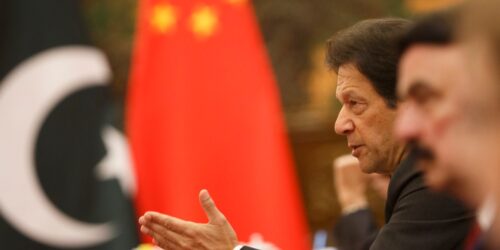Pakistan’s debt problems are escalating as liabilities due on China-funded energy projects established under the China-Pakistan Economic Corridor (CPEC) surpass $31 billion and Beijing declines to restructure $3 billion in liabilities coming due that Islamabad possibly won’t pay.
The debt load, owed largely for the building of independent power producers (IPPs) on take-or-pay power generation contracts, is substantially more than the $19 billion in total invested in the plants, according to reports and industry analysts.
Pakistan is obliged to pay $5.9 billion to the power companies for take-or-pay capacity payments alone over the next four years by 2025. Those will entail more pay than take at current power usage rates.
The money is owed despite the fact many of the plants are not actually producing power due to overcapacity and the failure of Pakistani power authorities to develop the national grid and related delivery systems to fully meet grassroots demand.
The contracts and their now perceived as onerous conditionalities were made at a time Pakistan faced acute power shortages.
Farrukh Saleem, an Islamabad-based political scientist, economist, financial analyst and former government spokesperson on economy and energy issues, told Asia Times that “circular debt” – a term he uses for the energy sector’s overall debt profile – is up from $7.2 billion in 2018 to $15.8 billion in 2021.
“The circular debt is projected to hit $26.3 billion by 2025. The capacity payment has also swelled from $4.4 billion to $5.9 billion and is going to increase to $9.8 billion in the next couple of years,” he claimed. He said the debts are now equivalent to 11% of the gross domestic product (GDP).
Pakistan has already entered what some analysts see as a sovereign debt “danger zone” with total liabilities and debts of $294 billion representing 109% as a percentage of GDP as of 30 December 2020.
The government owes about $158.9 billion to domestic creditors, of which public sector enterprises owe about $15.1 billion.
External debts owed have similarly surged to $115.7 billion, with $11.3 billion owed to the Paris Club, $33.1 billion to multilateral donors, $7.4 billion to the International Monetary Fund and $12 billion in international bonds.
Pakistan Bureau of Statistics data released this month revealed that the country’s trade deficit posted a double-digit rise in the 10 months of 2020-21 to $19.6 billion from $17.4 billion during the corresponding period last year.
Economic experts predict the debt-to-GDP ratio could double to 220% of GDP by the end of 2023 if debts continue to grow at the current clip – which would coincide with the end of Prime Minister Imran Khan’s debt-inflating five-year term.
Meanwhile, the fiscal deficit increased to 3.6% of GDP, or $10.8 billion, during the first nine months of the current fiscal year despite a drastic cut in development expenditures and static defense outlays.
Against that dire debt backdrop, Khan’s government tried in vain last year to renegotiate the terms of the power purchase agreements with Chinese IPPs in a bid to save the government $5.2 billion on electricity costs over the next 10-12 years.
The request to renegotiate followed an inquiry headed by a former chairperson of the Security and Exchange Commission of Pakistan (SECP) that revealed widespread malpractice in the power sector.
Sixteen IPPs invested around 60 billion rupees and earned over 400 billion rupees in profits in a period ranging from two to four years.
The same report pinpointed a loss of $26.1 billion to the state from the power sector over the last 13 years through inflated reporting of overhead expenses and operational costs, including for fuel consumption, bank fees and power generation costs used to calculate state subsidies.
The committee said power producers accrued over $26 billion in debts taken from banks to establish power units under the CPEC and subsidies to pay the power purchase agreements reached with the IPPs.
The report disclosed that some 16 IPPs, including seven Chinese ones, made “windfall” profits over a two- to four-year period. Although their agreements said they could make between 12-15% profits over their investments, some reaped profits of between 70-90%, according to the report.
Media reports suggest that Beijing has refused to budge on Islamabad’s request to renegotiate the power purchase agreements, saying that any debt relief would require Chinese banks to amend the terms and conditions under which the credits were extended.
The banks, including China Development Bank and the Export-Import Bank of China, were not prepared to revise any of the clauses of the agreement reached earlier with the government, Beijing said in response to the request to renegotiate terms.
That unrelenting line is believed by analysts to be in line with Beijing’s “rethink strategy” of its $1 trillion Belt and Road Initiative. Beijing is under pressure at home for the scheme’s financial loss-making projects and at the same time politicized criticism that its related loans create “debt traps” for recipient states.
Pakistan Tehrik-e-Insaf (PTI) Senator and industrialist Nauman Wazir told Asia Times, “First, the tariff determined by National Electric Power Regulatory Authority (NEPRA) at the time of allowing power generation in the private sector was on the very high side.
“Then, the IPPs submitted erroneous declarations concerning capital, financial assets and operational cost of the company, which became obvious when the balance sheets of the IPPs were made public,” he claimed citing evidence that came to light when an inquiry committee on Pakistan’s power sector revealed its findings last year.





